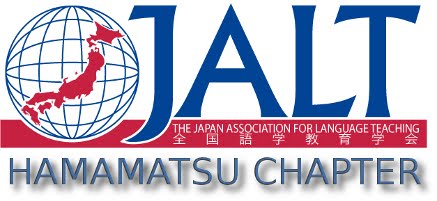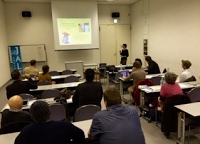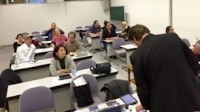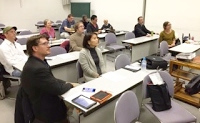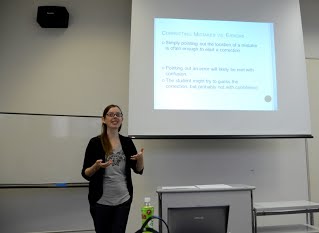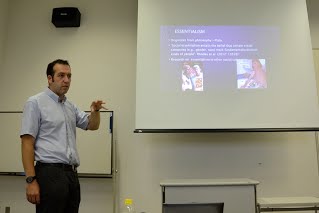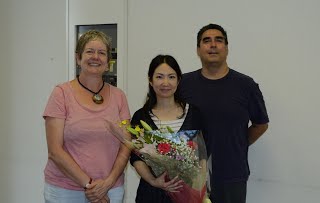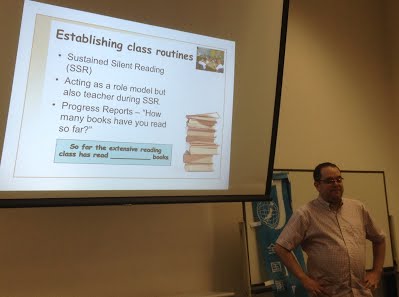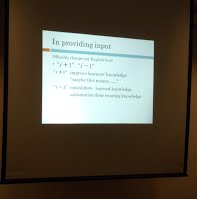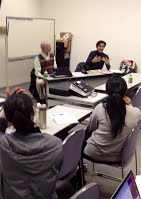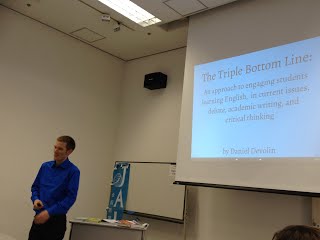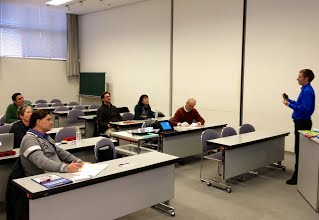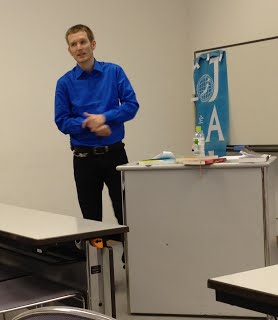2015 Meeting Minutes
December 12 -- My Share and year-end get-together
This year’s My Share offered many diverse ideas on many topics, underscoring the range and diversity of our membership. Thanks to those people who came from afar. 1.Bogdan Pavliy 50-word compositions Prof. Pavliy uses these with his students in Toyama. To demonstrate, everyone was required to write a 50-word composition based on a fairy tale. Writing a cogent story in just fifty words in under minute was very challenging. Fortunately, his students get more time than did! 2. Wendy Gough Journal Sharing builds communities … — empowers learners because they can freely write about whatever they want (share with their teacher) — journals give the writer a sense of security The presenter tried sharing classmates’ journals. Would it make students feel more engaged? She used two year-long classes. Students traded each other’s journals and were able to freely offer comments in another’s journal. This process was carried out for ten minutes. — As students started to engage with each other (closer bonds), the time was extended by several minutes. — Gough’s end-of-the-year questionnaire showed that students were very positive about the journal experience. 3. Jon Dujmovich Empathy is the cornerstone of communication — We need empathy first in order to communicate effectively (e.g., such as a parent’s gaze) — Even some cereal boxes are designed to sustain the eye contact of children — eye contact activates parts of the brain that facilitate/develop empathy — I was forced to stare into friend’s eyes for about a minute. It was quite uncomfortable. —This reporter questions whether empathy is the cornerstone of communication, but that’s for another time. 4. Gregg McNabb Online speed-reading — Online speed reading may allow teachers to control the pace in their classroom — Online speed reading can immediately improve students’ reading speed — Sullivan questioned McNabb’s assertion that reading on a cellphone is not real reading. And claimed that she has read an entire book in horizontal mode. This reporter would suggest that it might have been impaired reading unless the phone was a sizeable one. In any case, McNabb’s point was that using a cellphone to “read” takes away time from actual/better reading. 5. Michael Boyce Conflict resolution as it applies to natural disaster — Boyce’s presentation was a public service. — People should learn more about disaster readiness. — A decision tree for disaster readiness needs to be practiced. — He explained why certain emergency items are more valuable than others. — It is safe to say that most people who have made some preparations believe their preparations are not too bad. We learned that this is probably not the case. 6. Adam P. Simulation vs. imitation — He thinks too much imitation in textbooks is unnatural. Learning needs to be less controlled and more naturalistic. Let Japanese learners use their existing background knowledge (hunt and peck — find their way). It’s an interesting assertion, but surely learners need to be provided with a solid base first. 7. Adam J. Moodle Reader Extensive reading for marks. Marks for X number of words read — He showed us how the Moodle Reader works — mreader.org for people who do not have Moodle You must ask Tom Robb for permission to use the site. 8. Jane Joritz-Nakagawa Not Gender Free but Gender Fair Be mindful of our gender attitudes even when we feel we are being fair. Try to be random when choosing. Look for gender balance in content because there are enough from both sides. 9. Dan Mortali Team teaching — the good, the bad and the ugly — The Bad: Miscommunication , lack of cultural awareness, the level of seriousness of native speakers, underqualified native teachers, underutilisation of ALTs continues some 25 years later. — The Ugly: Should ALTs be called “assistants?“ It limits the roles of ALTs Japanese teachers often do not interact with ALTs — The Good: Collaboration, better teacher to student ratio, allowing students to see their teachers negotiating with an ALT is evidence that it’s not static. 10. Sue Sullivan Three Questions — Teaching mixed level classes Topic Private life vs public life Should Japan have an i.d. system? “Breaking News” is a good site for finding “stuff” related to the topic. Read an article and comment on it. Using Edmodo, comment on other students’s comments on Edmodo. Eventually, students give very short, speed presentations. |
HAMAMATSU: October – The Future of Hamamatsu JALT, October 17, 2015. 18:00-20:00 at Create Hamamatsu クリエイト浜松 Room 21
Members and the core officers discussed the current state of JALT on a national level and how chapters may have to rethink structures and operations for the overall health of the organization. As such, the possibility of Hamamatsu JALT approaching nearby chapters for potential merger was considered. The financial standing of the chapter was on the agenda (we are in good health), as were the ways and means of promoting membership and creating an inspiring program for the following year. For example, offering workshops for teachers, having a student voices event. |
September 20 : Marie Kjeldgaard, Aichi University: What Makes an Error? Common English Mistakes and How to Help Students Correct Them. ..... Nicholas Bradley, Nagoya University of Foreign Studies: My problem with culture.
July 11, 2015 -- Andy Boon: Setting up an extensive reading course: the beginning, the middle, and the end & Inspire or perspire? Getting students speaking.
Extensive reading (ER) is a great way to holistically improve students’ English practice and understanding. At our July meeting, Andy Boon (Toyo Gakuen University, Tokyo) outlined benefits and some useful activities to maintain student motivation and exploit all macro skills in this area. He had some terrific tips for increasing the ER library for schools holding a limited number of texts (e.g., one-coin book purchase) and walked us through an ER course of his making. His advice for structuring a course to best nurture the confidence of students in this field was for them to read at the appropriately graded level and create a routine for them to follow such as a certain amount of time for SSR, book reports due every week, etc. Student feedback indicated a deep satisfaction with their progress. Andy’s second presentation introduced the listening/speaking Cengage series, Inspire, of which he is a co-author. Through interactive tasks, Hamamatsu members experienced firsthand how the books’ content could be used in exciting and innovative ways to encourage learner participation in oral and aural activities. |
May 25, 2015 -- Dr Stephanie Pillai: The Re-colonization of English Language Education: The Case of Malaysia
Dr Pillai walked us through the labyrinthian complexities of the Malaysian educational system that sometiimes seemed to defy logic. Seemingly never-ending vacillating government policies have once again resulted in competent English language instruction being the domain of private schools, and therefore a prerogative of those who can afford them. Seeing as English ability is instrumental in gaining high status employment in Malaysia, its possession acts as a gatekeeping tool, creating and maintaining disparities among the strata of society. The current state of English language education has come a full circle whereby those with the opportunity to attain it are a minority, yet hold economic and social positions of power. |
March 28, 2015 Dan Frost & Prof. Rintaro Sato: Considering the use of L1 (Japanese) in English language classes: A discussion of its effectiveness
On March 28, 2015 Dan Frost and Professor Rintaro Sato of Nara University of Education examined the pros and cons of using L1 and L2 in class and to what extent both should and can be used. Dan Frost set out his arguments for only using English in the classroom (allowing Japanese for reference or confirmation only). There was some extended polite disagreement about this. Professor Sato argued for the judicious use of the Japanese language. While Frost argued in favor of even using English for explicit grammar instruction, Professor Sato generally rejected that, but did concede that in some instances Japanese grammar textbooks do go too far (e.g., no need for 私はサッカーが好きです for I like soccer). There was general agreement from the audience also that Japanese textbooks use too much Japanese. Sato suggested that future textbooks may get rid of a lot of unnecessary Japanese. We'll have to wait and see. During the course of the debate which was actually closer to a discussion, Professor Sato advocated first building up teacher talk in English and then trying to increase student talk (ideally 80%). He touched on the importance of creating a psychologically satisfying environment where students can feel as comfortable as possible using L2 with their peers. He stated his view that the JTE is a more suitable role model for learners than native-speaker teachers, which is frequently mentioned in the literature. There was a lot of lively interrogation from the audience so both presenters were called upon to carefully justify their positions. In the end it was concluded that only English in the classroom might be difficult and that there is still a great of room left for improvements in Japan's EFL programs. At this point the discussion became too far reaching so we adjourned. Reported by Gregg McNabb |
January 18, 2015 Dan Devolin: The Triple Bottom Line: An approach to engaging students learning English, in current issues, debate, academic writing, and critical thinking
Daniel Devolin (Aichi University) led Hamamatsu JALT into the New Year with a quick rundown on the economic and social relevance of The Triple Bottom Line (TBL). Based in economics, TBL or 3BL looks at the sustainable overlapping area(s) of societies, economies, and ecologies. This commonality can be a source of stability, and resource for maintaining and developing the interlocking conditions required to meet our global needs. Within university-level language learning, particularly focusing on current issues, debate, academic writing and critical thinking, TBL provides an introduction to interdisciplinary approaches. Topics can be explored through the three features of the theory, providing students with structure and direction when encountering cognitively challenging ideas. If correctly and gradually implemented, they develop tools and means to express their opinions and engage deeply with classmates on numerous subjects. Naturally, students need to feel comfortable seeking out ways of expression. Accordingly, classroom rapport is important so that inhibitions are reduced. Scaffolding is necessary. TBL is custom-made for group work. Individual groups can research a topic from one of three aspects, or individuals within groups are allocated one of the three. Thorough interaction with content encourages top down and bottom up processing. Students contribute new knowledge to wider classroom interaction in the form of presentations, written assignments, discussion and debate, and potentially absorb it into their broader schemata. While all of this is a lot to absorb, Dan presented this with enthusiasm and aplomb. Reported by Susan Sullivan |
